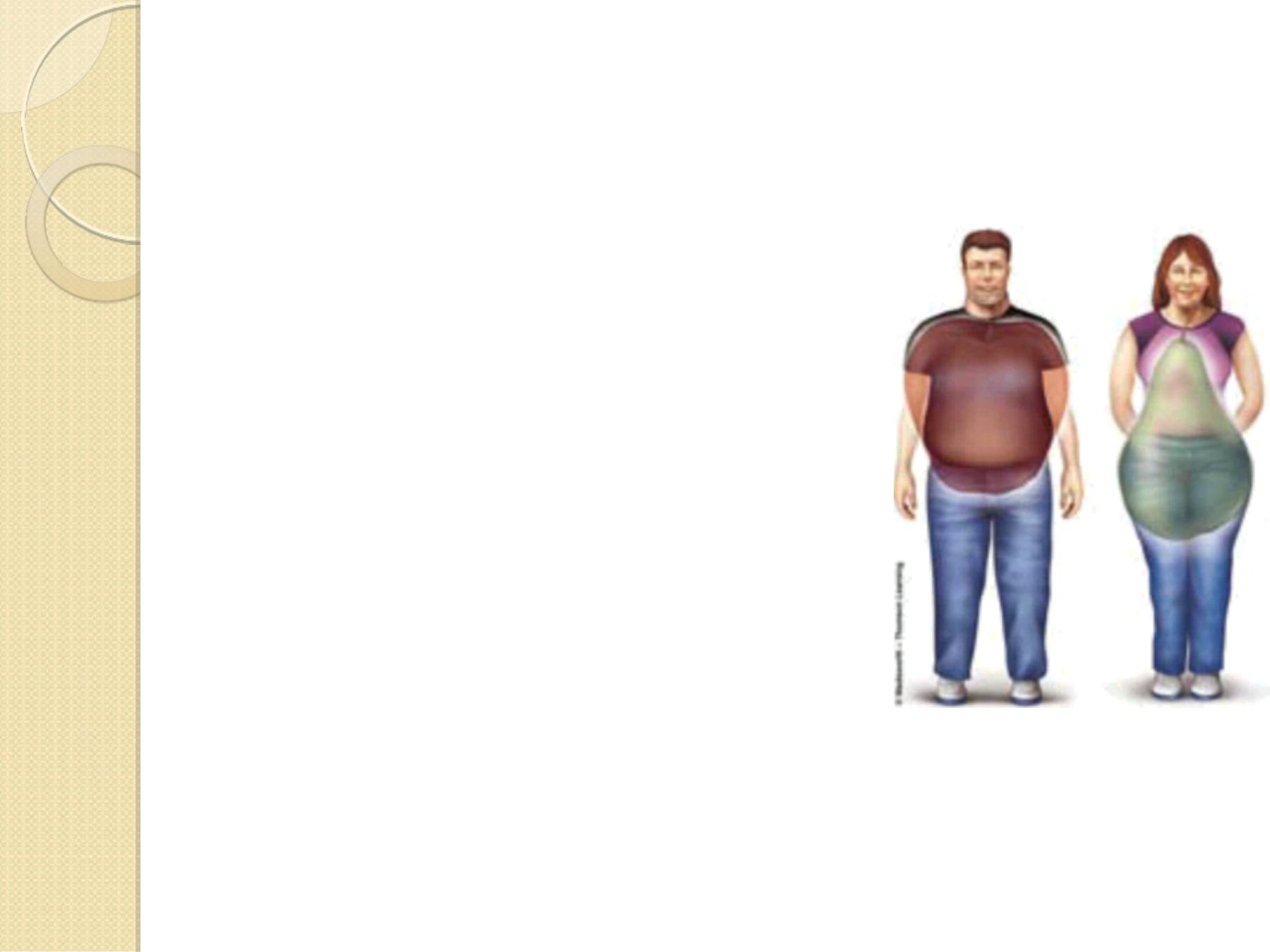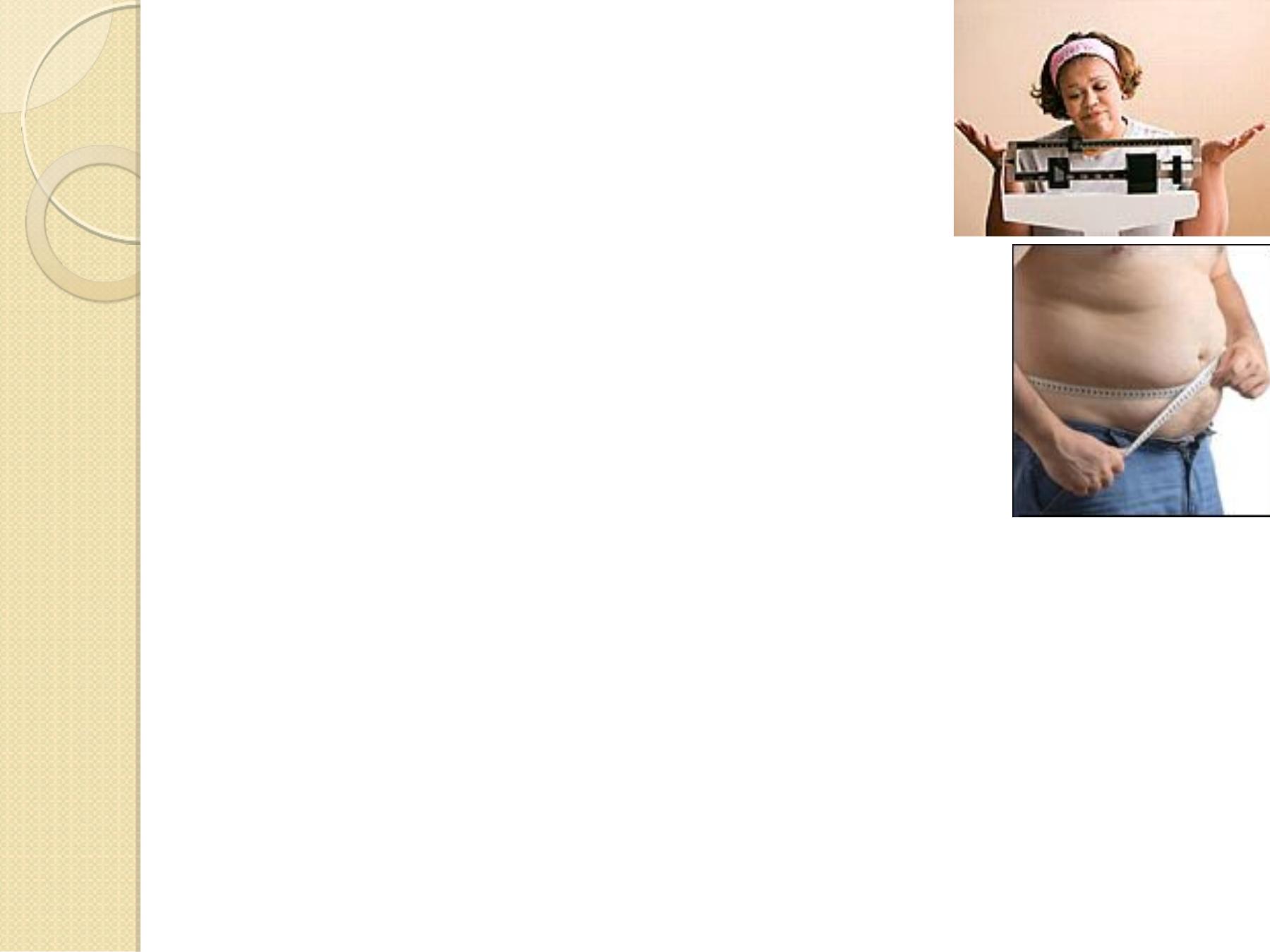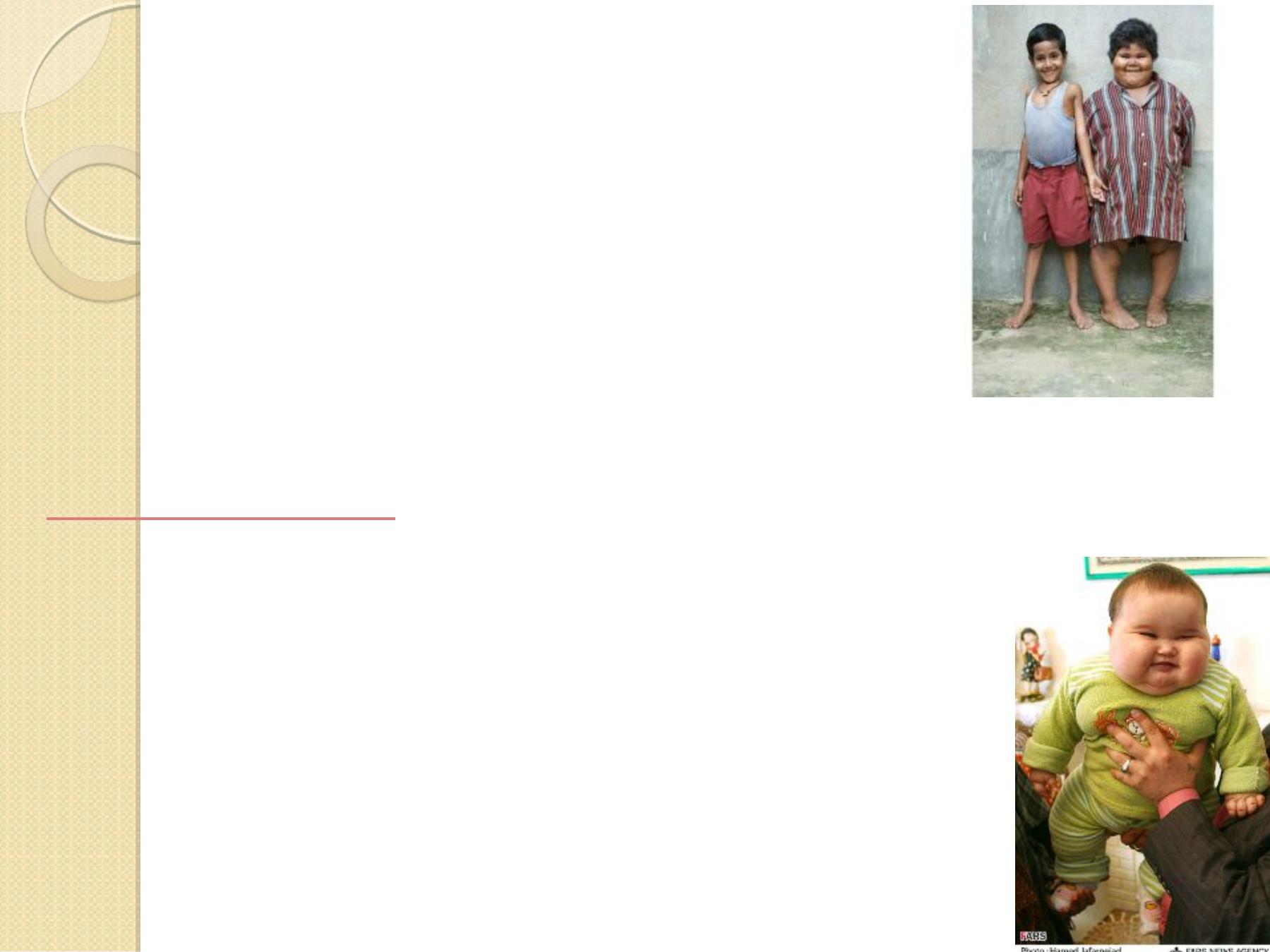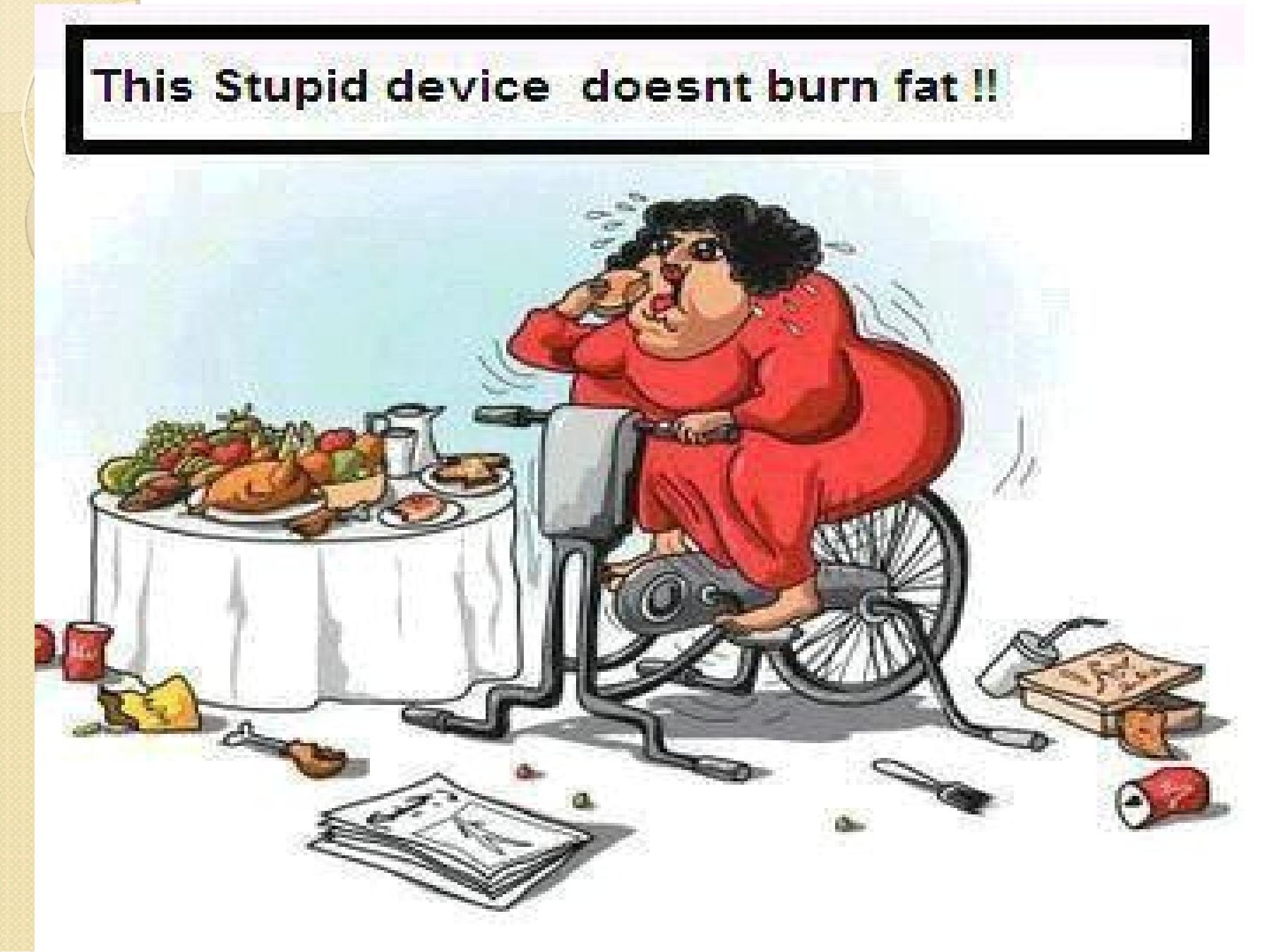
O
O
b
b
e
e
s
s
i
i
t
t
y
y

L
L
e
e
a
a
r
r
n
n
i
i
n
n
g
g
O
O
b
b
j
j
e
e
c
c
t
t
i
i
v
v
e
e
s
s
:
:
By t h e e n d o f t h i s l e c t u r e y o u w i l l b e
a b l e t o :
•
Un d e r s t a n d t h e r e l a t e d d e f i n it i o n s ,
e p i d e m i o l o g y
•
Me m o r i z e t h e ; c l a s s i f i c a t i o n s ,
c a u s e s , a s s e s s m e n t , c o m p l i c a t i o n s ,
m a n a g e m e n t , p r e v e n t i o n ,&
c h i l d h o o d o b e s i t y .

O
O
b
b
e
e
s
s
i
i
t
t
y
y
Ø
Is a medical term for over fatness
frequently resulting in a significant ill health.
§
It refers to excess body fat & adipose tissues.
§
The body weight increase 20% or more above the
IBW.
§
It is considered as a chronic disease associated with
illness & death from complications.
Ø
Over weight: is the excess wt./ht. by standard
tables 10% of IBW.
Ø
Ideal body weight: is the body wt. for a given ht.
that statistically associated with the greatest
longevity

Epidemiology:
—
Prevalence of obesity all over the world is
increasing, esp. in USA by 10-15%.
—
Females of highest prevalence of obesity while
males have higher rates of overweight.
—
Prevalence of obesity in western world
begin in infancy;
*1/3 or more of there infants are obese.
*School children obesity vary between
6-15%.
*The more the obesity in childhood the more the
obesity in adulthood.

—
Adolescent obesity 20-30 %.
—
80% of obese adolescents become obese adults.
—
Young women are more likely to be obese than
young men.
—
The obesity are more risk in young adult than to
older one.
—
The prevalence of obesity more in low
socioeconomic status.

Classification of obesity:
There are different classifications;
1-Hypertrophic obesity: result from
an increase lipid content of adipocytes,
(common in adults), mild- moderate obesity.
2- Hyperplasic- hypertrophic obesity: increase in
the fat cells numbers &lipid content of fat cells
(over feeding during infancy & adolescent leading
to permanent abnormality, therefore preventive
measures should taken during these periods).

Other classification; regional fat distribution;
excessive fat located in the central abdominal area
which is statistically associated with
increase risk of D.M., hypertension,
CVD, (common in males).
*
*
G
G
y
y
n
n
o
o
i
i
d
d
=
=
p
p
e
e
a
a
r
r
s
s
h
h
a
a
p
p
e
e
d
d
(
(
l
l
o
o
w
w
e
e
r
r
b
b
o
o
d
d
y
y
o
o
b
b
e
e
s
s
i
i
t
t
y
y
)
): the fat distributed
in the lower extremities around the
hip or femoral region, relatively
benign (common in females).
Fat below the waist is more difficult to lose than
above the waist.
*
*
A
A
n
n
d
d
r
r
o
o
i
i
d
d
=
=
A
A
p
p
p
p
l
l
e
e
s
s
h
h
a
a
p
p
e
e
d
d
(
(
u
u
p
p
p
p
e
e
r
r
b
b
o
o
d
d
y
y
)
)
o
o
b
b
e
e
s
s
i
i
t
t
y
y
:
:

Th e c a u s e s :
1-Metabolic; excess of calories than required to meet
metabolic demands store as triglycerides in
adipose tissues.
2-Sedentary life style.
3-Emotional: impaired self–
image & feeling of
inferiority, which leads to social isolation.
4-Acquired from family; genetically predisposed,
**two obese parents have a73% chance of
having obese offspring,
**if one obese parent has 41% chance
**two lean parents have only 9% chance.
**Strong correlation in identical twins.

5- Brown fat: some people seems to eat more than
others without gaining weight due to brown fat
hypothesis; pigmented brown adipose tissue
(around neck & chest).
It serves as caloric buffer that disposes excess of
energy when food intake is high & conserves
energy when food intake is low.
Defect in brown adipose tissue function or fewer
brown cells may be responsible.
6-Leptin hypothesis: mutation in a Ob gene causes a
severe hereditary obesity in mice,
It regulate the amount of body fat through control
of appetite & energy expenditure.

Assessment of obesity:
A-Body weight:
B-Height:
—
BMI
C-W aist to hip ratio:
Waist to hip circumference can identify
the two types of obesity.
—
A ratio of 0.7 considered as normal.
—
A ratio < 0.7 indicates lower body obesity.
—
A ratio > 0.7 indicates upper body obesity.
D-Skin fold thickness:
*18mm for men , >20mm excess fat.
*23mm for women, >25mm =
=
Fatty arms appear to run in families even when the
rest of the body have lower fat
.

M
M
e
e
d
d
i
i
c
c
a
a
l
l
c
c
o
o
m
m
p
p
l
l
i
i
c
c
a
a
t
t
i
i
o
o
n
n
s
s
:
:
Obesity is associated with number of chronic diseases
including;
—
Adult onset of diabetes: 2.9X higher prevalence.
—
Hypercholesterolemia: high plasma T.G., LDL.
Hypertension & heart disease, there is linear
association betw. B.W.& B.P. 5X with obesity.
—
Cancer: higher mort. from ca colon& prostate in
males, & breast in females.
—
Gall stones (related to incr. cholesterol synthesis)
—
Arthritis, & gout.
—
Undesirable social,& psychological consequences
of obesity.

N
N
u
u
t
t
r
r
i
i
t
t
i
i
o
o
n
n
&
&
C
C
h
h
r
r
o
o
n
n
i
i
c
c
D
D
i
i
s
s
e
e
a
a
s
s
e
e


—
Obesity associated with heavy menstrual blood
flow, irregular cycle, polycystic ovarian
syndrome& infertility.
—
Decrease life expectancy by 11% for males & 7%
for females for 10% incr. B.W., & when B.W. incr.
by 20% the life expectancy decr. 20% or more in
males & 10% in females.
On the other hand risk of osteoporosis is lower with
obesity.
Management for wt. reduction:
Body wt. represents the balance between energy
intake & energy expenditure.
To reduce B.W. requires negative energy balance.

Many strategies include;
The best approach to lose wt. is to follow
a balanced mildly hypo caloric diet.
—
Diet; to lose 500gm/wk, the patient should
reduce caloric intake by 500Kcal/day =
3500Kcal/wk = max. loss 2kg/m. & or
—
Exercise; incr. physical activity which
result in expenditure of 500Kcal; running
for 45min., playing tennis 60min.,
walking 75min., bicycling 90min.
—
Behavioral modification: eating when hungry,&
stopping with first sign of satiety, small, regular &
frequent meals.

—
Surgical treatment (for morbid obesity),
**creating smaller bowel( produce mal absorption
of calories)
**or creating small stomach to reduce the reservoir
for food +dietary treatment is particularly
effective for initial wt. loss.
**It is advisable to take multivitamins–
mineral pills
to prevent essential nutrients deficiencies.
v
Repeated cycles of wt. lose & regain called yo-yo
dieting which takes longer to lose wt. & shorter to
regain it when the cycles are repeated.

Obe s ity Among Ch ildre n:
—
Obesity; 1:4 children and 1:5
adolescents are now classified as obese.
—
Prevalence has increased 50% in
children in last 10years.
Management:
Deal with weight gain through
growth,
do not put the child on a
weight loss diet
, let the child maintain
the current weight while he grows taller.

G
G
e
e
n
n
e
e
r
r
a
a
l
l
s
s
t
t
r
r
a
a
t
t
e
e
g
g
i
i
e
e
s
s
f
f
o
o
r
r
o
o
b
b
e
e
s
s
i
i
t
t
y
y
p
p
r
r
e
e
v
v
e
e
n
n
t
t
i
i
o
o
n
n
:
:
The prevention of obesity in infants and young
children should be considered of high priority.
The main preventive strategies are:
—
The promotion of exclusive breastfeeding
—
Avoiding the use of added sugars and
starches with feeding formula.
—
Instructing mothers to accept their child’
s
ability to regulate energy intake rather than feeding
until the plate is empty.
—
Assuring the appropriate micronutrient intake
needed to promote optimal linear growth.

—
Promote an active lifestyle.
—
Limit television viewing.
—
Promote the intake of fruits& vegetables
—
Restrict the intake of energy-dense,
micronutrient-poor foods (e.g. packaged
snacks)
—
Encourage healthy eating habits& lifestyle,
to prevent adult onset of diseases related to nutrition.
—
Enhance physical activity in schools &communities.
—
Eating family meals
—
Restrict the intake of sugars-sweetened soft drinks.



